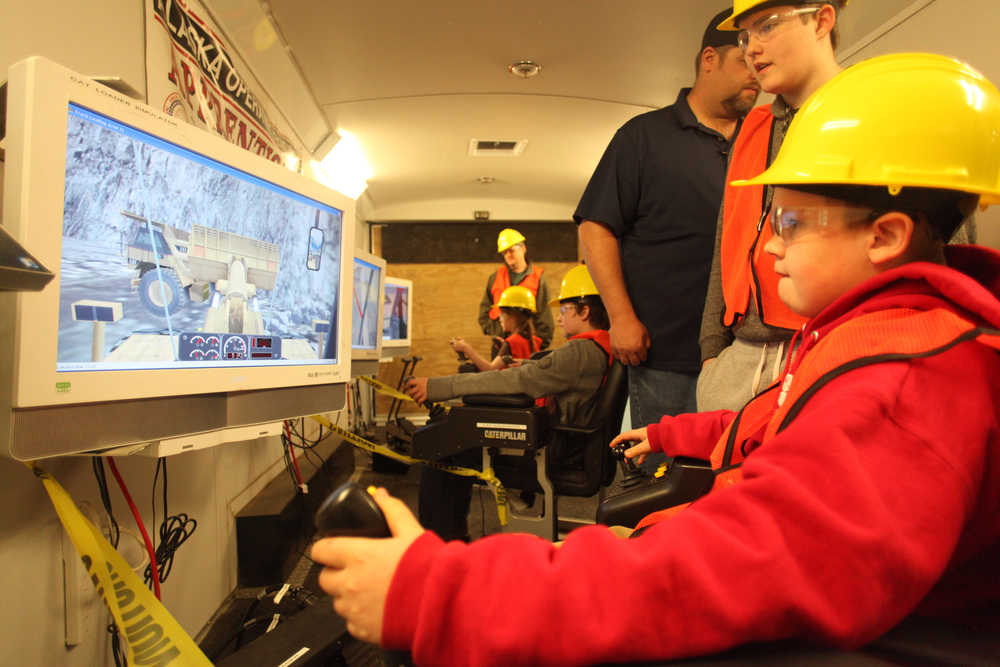State and local agencies convened Friday to bridge the gap between up-and-coming members of Alaska’s workforce and one of the state’s critical sectors.
The Alaska Department of Transportation and Public Facilities Civil Rights office partnered with the Kenai Peninsula Borough School District to bring local students to Alaska Construction Career Days at the Soldotna Regional Sports Complex. While this is roughly the fourth time the event has been set up on the central Kenai Peninsula, it was the first year middle school students were invited to attend.
The more knowledge students have when they decide on their chosen career path, the more likely they are to succeed, said Sara Moore, the school district’s counselor-specialist. When students are shown their options earlier, they can apply those experiences in the classroom, and even choosing what courses they want to complete becomes easier, she said.
Rachel O’Brien, the regional manager at the Peninsula Job Center in Kenai, agreed with Moore. She said events like the construction career fair take personal exploration a step further by integrating opportunities to receive hands-on training, which increases the chance that students will connect with a potential job they hadn’t previously considered.
While Moore said the school district allows students to choose where they go for school and start their career, O’Brien tries to promote Alaskans filling up Alaska’s workforce.
“Our goal is to have kids graduate, within whatever education they chose, and bring it back to Alaska, or stay and use those skills, ” O’Brien said.
She said by making sure more graduating students are qualified for available positions, it ensures the future of the state by fueling economic growth in a sustainable way.
Matt DeLabruere, assistant coordinator for Alaska Construction Career Days, said the event, in its 10th year overall, has reached 8,000 students in Alaska in 14 school districts. It requires extensive coordination between a variety of private and public organizations, he said.
“It keeps the knowledge within the state,” DeLabruere said. “It keeps the economy going.”
Further, it shows students there are more pathways they can take if they aren’t ready for or are uninterested in attending college.
“You have got kids who have never picked up a hammer before and are surprised to find they have other options,” DeLabruere said. “They can learn a skill right out of school that can last them a lifetime.”
Matt Widaman, school district Career Technology Education Coordinator, said the event also tends to help students who may be floundering in the classroom setting.
“It’s good if they can identify with some of those trades,” Widaman said. “At least it gets them thinking about things.”
Leonard Lawson, a Journeyman Carpenter Laborer Specialist for the staffing organization Skills Unlimited, said events like the construction career fair are invaluable for students to understand the choice they are making. A person may study and plan but they won’t learn significant details until they actually get to the job, he said.
“It may make sense on paper, but that doesn’t tell the whole story,” Lawson said.
For example, the constant barrage of loud noises on a building site can be a surprise for some people, he said. Lawson was in charge of the large groups of students that were building basic birdhouses during rotations Friday. While it seemed like a simple task, he said just making one house can teach important skills, including the proper way to use a hammer and how to pay attention to detail.
“It is a dangerous business if you don’t pay attention,” he said.
Lawson said the benefits of a career in construction are unbeatable. It is open, so anyone can switch specialties if one is worn out, and there is a constant feeling of gratification by seeing what a person’s own two hands have accomplished. And, the state will always need construction workers.
“Alaska is constantly building,” Lawson said.
Even old infrastructure needs upkeep, so there will always be open jobs in the field he said.
Alaska’s Department of Labor follows “Building Alaska’s Construction Workforce, A Comprehensive Workforce Development Plan,” which was prepared by the Alaska Workforce Investment Board in 2006 as a strategic plan to fill the state’s construction jobs with Alaskans.
“Alaska is experiencing a critical shortage of resident workers with construction skills. 20 percent of construction workers are new arrivals to the state,” according to the report.
The field has seen layoffs recently, and 900 jobs are expected to be eliminated this year as public funding on capital projects dwindles, according to the Department of Labor’s “Alaska Economic Trends January 2016 Trends” report.
Tim Squire, apprentice coordinator for the Alaska Boilermakers union, said half of the jobs filled in the field last year were by people from Outside. He said he wants that to change, and fast, and like many of the other event recruiters promoted the wages, paid apprenticeships and training, and benefits construction workers will receive throughout their lifetime.
Soldotna High School student Margaret McGlothen was finishing up a birdhouse around noon Thursday, and said she felt the event exposed herself and her peers to a basic skill set they could continue to build on, and for many, a broad range of options to consider postgraduation.
“It gives them different options, and they get exposure, and just by getting exposure they will learn,” McGlothen said.
Reach Kelly Sullivan at kelly.sullivan@peninsulaclarion.com.

